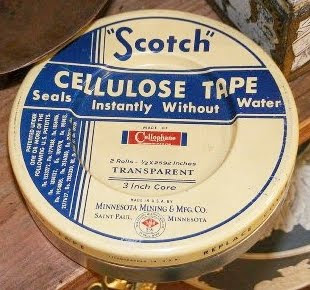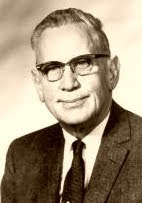Philosophy

 Richard Gurley Drew
Richard Gurley Drew
June 22nd, 1899 to December 14th, 1980
Okay, it is common knowledge that Red Green [Canadian humorist] invented Duct Tape [NOT] and not so common knowledge that Richard Drew invented transparent adhesive tape [NOT NOT].
In 1930, Scotch tape was developed by Richard G. Drew at 3M, St. Paul Minn. Originally, 3M only made sandpaper, and during testing Drew observed at a local auto bodyshop that auto painters had difficulty making clean dividing lines on two-color paint jobs. After two years of effort in the company's labs, he invented masking tape (1925), a tan paper tape with a light, pressure sensitive adhesive backing. Five years later, he invented Scotch Brand Cellulose Tape, the first waterproof, see-through, pressure-sensitive tape.
About.com...
In 1923, Richard Drew joined the 3M company located in St. Paul, Minnesota. At the time, 3M only made sandpaper. Drew was product testing 3M's Wetordry brand sandpaper at a local auto bodyshop, when he noticed that auto painters were having a hard time making clean dividing lines on two-color paint jobs. Richard Drew was inspired to invent the world's first masking tape in 1925, as a solution to the auto painters' dilemma.
Brandname Scotch:
The brandname Scotch came about while Richard Drew was testing his first masking tape to determine how much adhesive he needed to add. The bodyshop painter became frustrated with the sample masking tape and exclaimed, "Take this tape back to those Scotch bosses of yours and tell them to put more adhesive on it!" The name was soon applied to the entire line of 3M tapes.
Scotch Brand Cellulose Tape was invented five years later. Made with a nearly invisible adhesive, the waterproof transparent tape was made from: oils, resins, and rubber; and had a coated backing.
According to 3M:
Richard Drew, a young 3M engineer, invented the first waterproof, see-through, pressure-sensitive tape, thus supplying an attractive, moisture-proof way to seal food wrap for bakers, grocers, and meat packers. Drew sent a trial shipment of the new Scotch cellulose tape to a Chicago firm specializing in package printing for bakery products. The response was put this product on the market! Shortly after, heat sealing reduced the original use of the new tape. However, Americans in a depressed economy discovered they could use the tape to mend a wide variety of things like torn pages of books and documents, broken toys, ripped window shades, even dilapidated currency.
- Is There Nothing Duct Tape Can't Fix?
Have a wart? Say goodbye drug store, hello hardware store. According to several studies (here's one), duct tape is as or more effective in treating the common wart than the standard approach of freezing them off with liquid nitrogen. There are other...
- Bing Crosby, Ampex, Silicon Valley
"How Bing Crosby and the Nazis Helped to Create Silicon Valley" by Paul Ford May 13th, 2013 The New Yorker The nineteen-forties Bing Crosby hit “White Christmas” is a key part of the national emotional regression that occurs every Christmas. Between...
- Lunar Orbiter Image Recovery Project
"Lunar Orbiter Image Recovery Project" March 5th, 2013 RocketHub We are looking for people to help us complete the Lunar Orbiter Image Recovery Project (LOIRP). We call this technoarchaeology - mining the past to support science in the future. ...
- The Falling Tree And Knowledge
VALIDATION OF EVENTS AND A CHANGE IN EPISTEMOLOGY "To sense or not to sense/to exist or not to exist"--It is just the way we observe and analyze the universe in that we conceptualize and formulate laws that explain things whether we are there are not....
- The "truth" Is Out There?
"An argument ensues between Frasier and Roz, and they retire to the control room to have it out in private. As they do, Glenn -- in the studio all by himself -- begins...completely out of context with anything else that has happened in the show, or with...
Philosophy
Richard Drew...Scotch tape

 Richard Gurley Drew
Richard Gurley Drew June 22nd, 1899 to December 14th, 1980
Okay, it is common knowledge that Red Green [Canadian humorist] invented Duct Tape [NOT] and not so common knowledge that Richard Drew invented transparent adhesive tape [NOT NOT].
In 1930, Scotch tape was developed by Richard G. Drew at 3M, St. Paul Minn. Originally, 3M only made sandpaper, and during testing Drew observed at a local auto bodyshop that auto painters had difficulty making clean dividing lines on two-color paint jobs. After two years of effort in the company's labs, he invented masking tape (1925), a tan paper tape with a light, pressure sensitive adhesive backing. Five years later, he invented Scotch Brand Cellulose Tape, the first waterproof, see-through, pressure-sensitive tape.
About.com...
In 1923, Richard Drew joined the 3M company located in St. Paul, Minnesota. At the time, 3M only made sandpaper. Drew was product testing 3M's Wetordry brand sandpaper at a local auto bodyshop, when he noticed that auto painters were having a hard time making clean dividing lines on two-color paint jobs. Richard Drew was inspired to invent the world's first masking tape in 1925, as a solution to the auto painters' dilemma.
Brandname Scotch:
The brandname Scotch came about while Richard Drew was testing his first masking tape to determine how much adhesive he needed to add. The bodyshop painter became frustrated with the sample masking tape and exclaimed, "Take this tape back to those Scotch bosses of yours and tell them to put more adhesive on it!" The name was soon applied to the entire line of 3M tapes.
Scotch Brand Cellulose Tape was invented five years later. Made with a nearly invisible adhesive, the waterproof transparent tape was made from: oils, resins, and rubber; and had a coated backing.
According to 3M:
Richard Drew, a young 3M engineer, invented the first waterproof, see-through, pressure-sensitive tape, thus supplying an attractive, moisture-proof way to seal food wrap for bakers, grocers, and meat packers. Drew sent a trial shipment of the new Scotch cellulose tape to a Chicago firm specializing in package printing for bakery products. The response was put this product on the market! Shortly after, heat sealing reduced the original use of the new tape. However, Americans in a depressed economy discovered they could use the tape to mend a wide variety of things like torn pages of books and documents, broken toys, ripped window shades, even dilapidated currency.
- Is There Nothing Duct Tape Can't Fix?
Have a wart? Say goodbye drug store, hello hardware store. According to several studies (here's one), duct tape is as or more effective in treating the common wart than the standard approach of freezing them off with liquid nitrogen. There are other...
- Bing Crosby, Ampex, Silicon Valley
"How Bing Crosby and the Nazis Helped to Create Silicon Valley" by Paul Ford May 13th, 2013 The New Yorker The nineteen-forties Bing Crosby hit “White Christmas” is a key part of the national emotional regression that occurs every Christmas. Between...
- Lunar Orbiter Image Recovery Project
"Lunar Orbiter Image Recovery Project" March 5th, 2013 RocketHub We are looking for people to help us complete the Lunar Orbiter Image Recovery Project (LOIRP). We call this technoarchaeology - mining the past to support science in the future. ...
- The Falling Tree And Knowledge
VALIDATION OF EVENTS AND A CHANGE IN EPISTEMOLOGY "To sense or not to sense/to exist or not to exist"--It is just the way we observe and analyze the universe in that we conceptualize and formulate laws that explain things whether we are there are not....
- The "truth" Is Out There?
"An argument ensues between Frasier and Roz, and they retire to the control room to have it out in private. As they do, Glenn -- in the studio all by himself -- begins...completely out of context with anything else that has happened in the show, or with...
